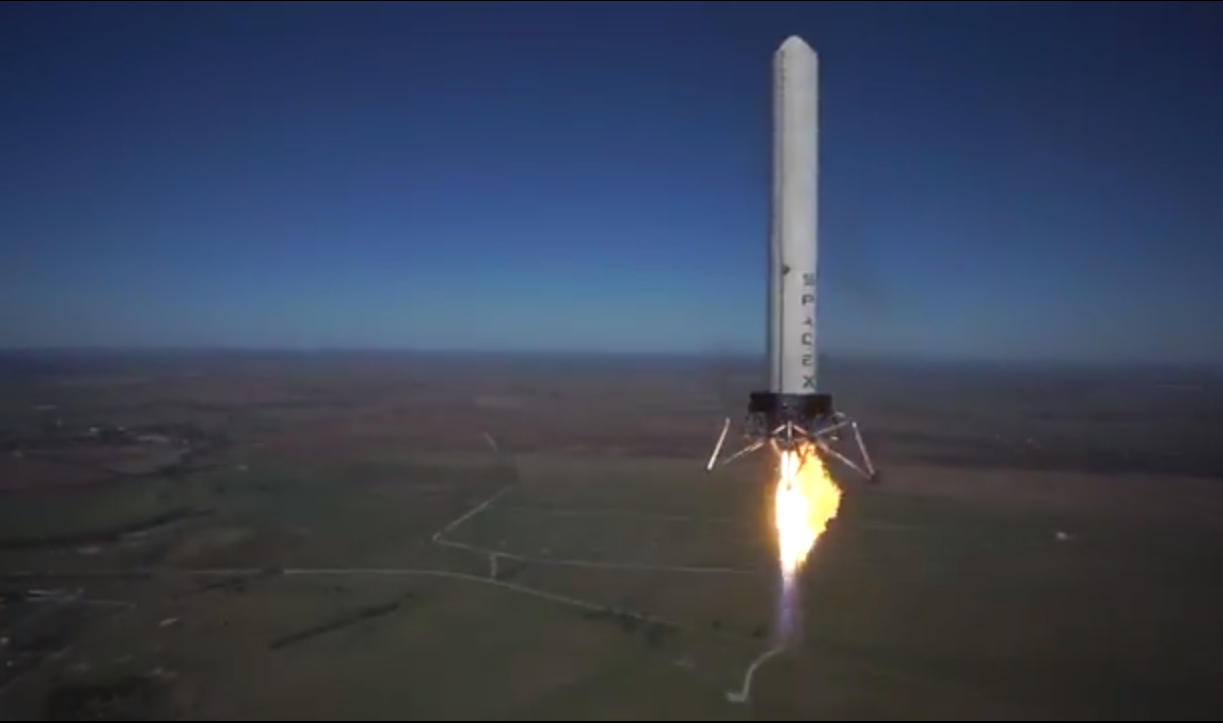SpaceX's Reusable 'Grasshopper' Rocket Soars in Highest Test Flight Yet (Video)

An experimental reusable rocket prototype built by the private spaceflight company SpaceX has made its highest leap yet, soaring more than 2,000 feet above its Texas proving ground as a camera captured the eye-popping test.
SpaceX's Grasshopper rocket made the giant leap on Oct. 7 and climbed 2,441 feet (744 meters) into the air before safely landing back on its launch pad in McGregor, Texas. SpaceX officials unveiled the amazing video of Grasshopper's highest hop yet on Saturday (Oct. 12).
The video shows Grasshopper flying high into the air while the hexacopter, already aloft, records the flight with video camera eye. The multirotor, unmanned drone captures an incredible shot of the rocket as it begins its descent. The entire test takes less than 1.5 minutes from liftoff to landing. [SpaceX's Grasshopper, the Amazing Reusable Rocket (Photos)]
"While most rockets are designed to burn up on atmosphere reentry, SpaceX rockets are being designed not only to withstand reentry, but also to return to the launch pad for a vertical landing," SpaceX officials wrote in a video description. "The Grasshopper VTVL [Vertical Takeoff Vertical Landing] vehicle represents a critical step towards this goal."
A Grasshopper launch in August demonstrated the reusable vehicle's ability to hop sideways while in midair. For that test, the experimental rocket launched to an altitude of 820 feet (250 m), hovered, moved 328 feet (100 m) sideways and then returned to the launch pad.
The most recent test is only the latest in a series of ever-higher flights for Grasshopper. Previous launches took place in September, November and December of 2012. During those flights, Grasshopper reached altitudes of 8.2 feet (2.5 m), 17.7 feet (5.4 m) and 131 feet (40 m) respectively. Its highest hops in March and April of 2013 took the reusable rocket to peak altitudes of 263 feet (80 m) and 820 feet (250 m). In June, Grasshopper climbed to an altitude of 1,066 feet (325 m) before safely maneuvering back to the ground.
The Grasshopper rocket, known at SpaceX as the Falcon 9 test rig, is about 10 stories tall. It uses the first-stage tank of the Falcon 9 — the rocket used to launch the company's Dragon capsule to the International Space Station. Grasshopper only uses one Merlin engine unlike the Falcon 9, which sports nine of the privately developed rocket engines as its name suggests.
Get the Space.com Newsletter
Breaking space news, the latest updates on rocket launches, skywatching events and more!
The Hawthorne, Calif.-based private spaceflight company holds a $1.6 billion contract with NASA to make 12 unmanned supply runs to the station. SpaceX has flown two of those cargo missions for NASA already, with the next visit to the station scheduled for early 2014.
Follow Miriam Kramer @mirikramer and Google+. Follow us @Spacedotcom, Facebook and Google+. Original article on SPACE.com.
Join our Space Forums to keep talking space on the latest missions, night sky and more! And if you have a news tip, correction or comment, let us know at: community@space.com.

Miriam Kramer joined Space.com as a Staff Writer in December 2012. Since then, she has floated in weightlessness on a zero-gravity flight, felt the pull of 4-Gs in a trainer aircraft and watched rockets soar into space from Florida and Virginia. She also served as Space.com's lead space entertainment reporter, and enjoys all aspects of space news, astronomy and commercial spaceflight. Miriam has also presented space stories during live interviews with Fox News and other TV and radio outlets. She originally hails from Knoxville, Tennessee where she and her family would take trips to dark spots on the outskirts of town to watch meteor showers every year. She loves to travel and one day hopes to see the northern lights in person. Miriam is currently a space reporter with Axios, writing the Axios Space newsletter. You can follow Miriam on Twitter.









